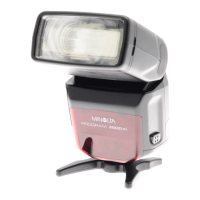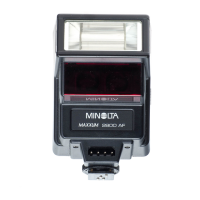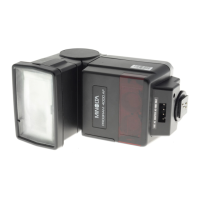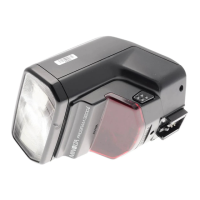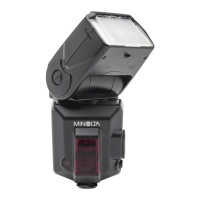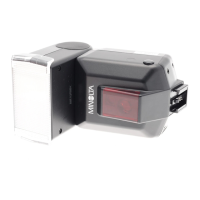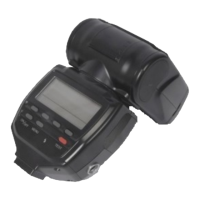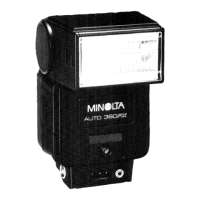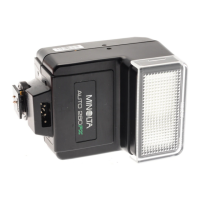Do you have a question about the Minolta MAXXUM_FLASH_5400HS - PART 2 and is the answer not in the manual?
Identifies and illustrates the physical components and external features of the flash unit.
Step-by-step instructions on how to securely mount and dismount the flash from the camera.
Explains how the flash range is displayed on the data panel and its interpretation in different modes.
Guide on inserting AA batteries into the flash unit to provide power for operation.
Details the performance characteristics of different battery types, including flash count and recycling times.
Instructions for operating the power switch and managing the automatic power-off feature to conserve battery.
Explains the meaning of various signals that appear in the camera's viewfinder related to flash status.
Instructions on how to tilt and rotate the flash head for softer lighting effects using bounce techniques.
Details the autofocus assist light function, its range, and when it automatically activates.
Explains the function and operation of the TEST button for flash checks and the LIGHT button for the data panel.
Describes how to use the MODE button to cycle through and select the four main flash operating modes.
Explains the default operational mode offering flexibility with TTL or manual settings for creative control.
Details how the flash output is regulated through the lens (TTL) for accurate and automatic exposures.
Instructions for selecting manual power levels to precisely control flash output for exposure in M mode.
How the flash head automatically adjusts coverage for different focal lengths and manual selection options.
Enables flash synchronization with camera shutter speeds faster than the standard 1/200 sec.
How to preview lighting effects and shadows before taking a picture using two modeling flash modes.
Using the flash wirelessly for creative lighting setups, controlled remotely from the camera.
Capturing multiple sequential flash images on a single frame for motion studies or creative effects.
Setting specific lighting ratios between multiple flashes for advanced control over light distribution.
Guidelines for maintaining, cleaning, and storing the flash unit safely to ensure longevity.
Lists and illustrates compatible accessories that enhance the functionality of the flash unit.
Provides comprehensive specifications, guide numbers, flash parameters, and compatibility information.
Identifies and illustrates the physical components and external features of the flash unit.
Step-by-step instructions on how to securely mount and dismount the flash from the camera.
Explains how the flash range is displayed on the data panel and its interpretation in different modes.
Guide on inserting AA batteries into the flash unit to provide power for operation.
Details the performance characteristics of different battery types, including flash count and recycling times.
Instructions for operating the power switch and managing the automatic power-off feature to conserve battery.
Explains the meaning of various signals that appear in the camera's viewfinder related to flash status.
Instructions on how to tilt and rotate the flash head for softer lighting effects using bounce techniques.
Details the autofocus assist light function, its range, and when it automatically activates.
Explains the function and operation of the TEST button for flash checks and the LIGHT button for the data panel.
Describes how to use the MODE button to cycle through and select the four main flash operating modes.
Explains the default operational mode offering flexibility with TTL or manual settings for creative control.
Details how the flash output is regulated through the lens (TTL) for accurate and automatic exposures.
Instructions for selecting manual power levels to precisely control flash output for exposure in M mode.
How the flash head automatically adjusts coverage for different focal lengths and manual selection options.
Enables flash synchronization with camera shutter speeds faster than the standard 1/200 sec.
How to preview lighting effects and shadows before taking a picture using two modeling flash modes.
Using the flash wirelessly for creative lighting setups, controlled remotely from the camera.
Capturing multiple sequential flash images on a single frame for motion studies or creative effects.
Setting specific lighting ratios between multiple flashes for advanced control over light distribution.
Guidelines for maintaining, cleaning, and storing the flash unit safely to ensure longevity.
Lists and illustrates compatible accessories that enhance the functionality of the flash unit.
Provides comprehensive specifications, guide numbers, flash parameters, and compatibility information.
| Power Source | 4 x AA Batteries |
|---|---|
| TTL | Yes |
| High Speed Sync | Yes |
| AF Illuminator | Yes |
| Guide Number | 54 m, ISO 100 at 105mm |
| Swivel Angle | 180° (Left/Right) |
| Coverage | 24-105mm |
| Wireless | Yes |
